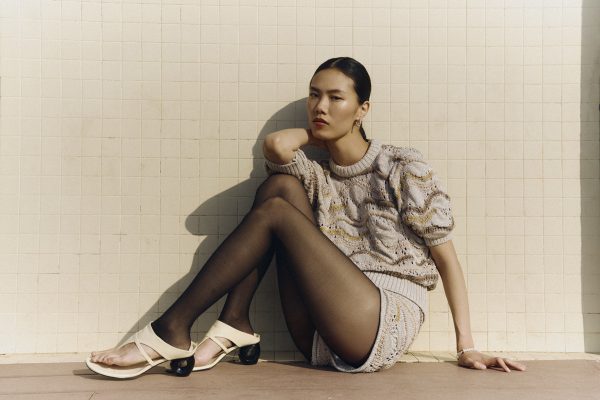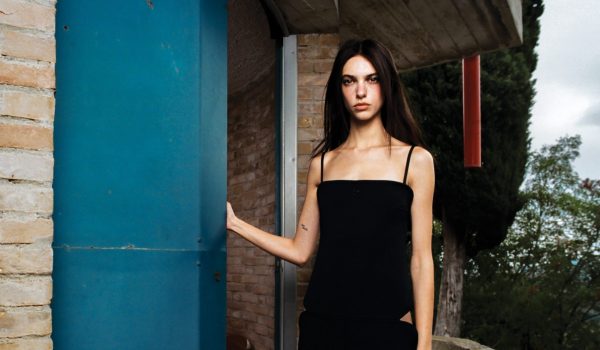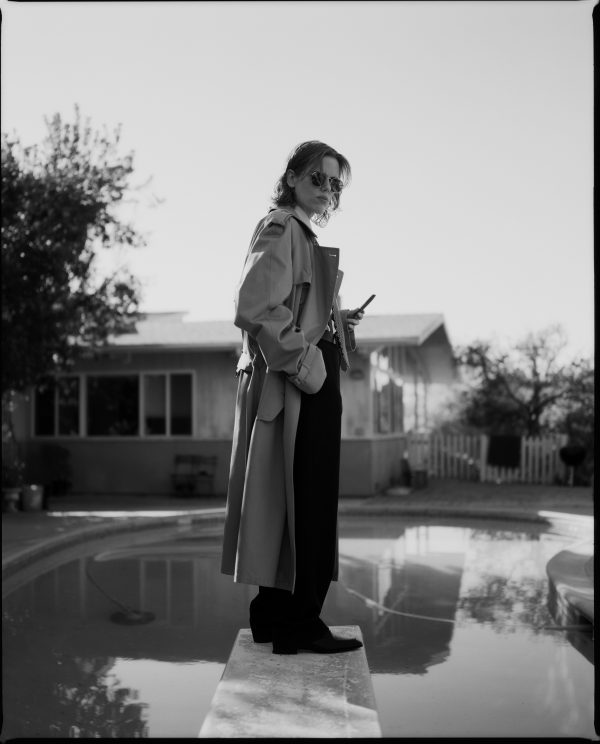
opposite
dress. Dolce & Gabbana
shoes. Fendi
As conversations about sustainability make their way mainstream, more and more people are looking deep into their closets and heading out to charity shops to see what vintage treasures they can discover. But for Ondine Patout, vintage isn’t a new passion — styling and treasure hunting for vintage pieces has been a part of her life as long as she can remember. Now, she runs Nymfavintage — a women-centric curator, seller and archive of vintage clothing. Schön! sat with Patout for a talk about her history and Nymfavintage.
Tell us a bit about your history and how you came to open Nymfavintage.
As a former luxury womenswear designer, creating elaborate pieces for strong women was a daily task. Vintage research has always been part of the job, starting from school. People in the industry use rare or particular pieces from another time as a base and inspiration for creation. I was also thrifting on the side for myself. It was a way to find individuality: the thrill of finding one-of-a-kind pieces and creating looks with my existing wardrobe. It really contributed to perfecting my personal style. After realising I was spending all my time researching vintage and deciding to be more sustainable, wearing and buying new was not something I considered anymore. The thrill of vintage research has since become an essential part of my life. I grew up in the 90s and 2000s looking up to ambitious and confident female icons. Being a feminist at heart, I wanted this project to have another purpose and be about women and self-expression. So, I put it all together.
The business has three parts — the e-shop, the archive, and nymfaworld. Can you tell us more about each of these three parts and what makes them distinct?
The e-shop is for women to wear what makes them feel great and confident: a selection of one-of-a-kind quality (mostly) designer vintage clothing. The archive is to rent and inspire professionals, a base for creation, for new imagery or designs. Nymfaworld is an extension: the clothes actually at work! Styling, collaborations — a way to put women in the centre of the project through imagery.

dress. Comme Des Garçons
earring. Sister Morphine

top. Balenciaga
opposite
top. Balenciaga
What inspired your Spring Lookbook and the collaboration with Amèlie Bernard?
It was very intuitive. I actually didn’t have a moodboard for this shoot — something like this was obvious for me. For this lookbook, I wanted to collaborate with a female artist, as all my collaborations are to promote women in the arts. Amélie Bernard’s work is about motion, evolution. There are oppositions in the materials used for the art pieces as well as in the clothing chosen, in textures, opacity, colours. I wanted to capture coexistence between something raw and organic, and softness, like a balance between strength and fragility. The atelier represents work-in-progress: a form of sincerity, revealing part of an artist.
Also, the space was something. We were on the 13th floor with no buildings in front and big windows allowing the sunshine to fill the room. As we shot with natural light, the lighting was evolving during the day, so you can actually feel the different times of the day in the photos. And because of the transparent materials in the art piece, stray lights were reflecting all over the space and kept on changing direction. The sun was actually guiding the atmosphere, and this was entirely improvised. At the end of the day, we could actually see the sunset, giving us warmer lighting, adding a more poetic vibe. If you are in Paris, Amélie’s space is open for visits until May 23rd!
You also cast this shoot. How did you find these models? And what about them made you want to choose them?
Inclusivity is an obvious choice for me as I am myself a POC woman… Due to Covid, Instagram has been an alternative for meeting people. Meeting people virtually is pretty particular as you tend to go straight to your common interests. You don’t choose a model through Instagram the same way you would choose through a traditional casting agency. Having access to their profile gives you access to their lifestyle, their inspiration, their work: they become interesting in another way. You choose for who they are, how inspiring they can be, what they represent, not only what they look like. The woman incarnation goes on another level and is more sincere. It was important for me to find two very different profiles who both share the same values as me.

top. Ann Demeulemeester
opposite
top. Tao Comme Des Garçons
What ideas about Nymfavintage were you looking to capture/express with these photos?
First, I wanted to express collaboration. It is indeed an encounter of many worlds: the artist’s, the models’, the space, the designers’ of the clothing and mine. Through this collaboration, I wanted my values to stand out: strength, fierceness, confidence, diversity, sensuality. I guess a collaboration of so many horizons is another way to interpret diversity, too.
How does the company make sure to maintain its eco-consciousness?
Having no production is one thing. Encouraging people to buy less and better: buy vintage pieces — as they are often an inspiration for today’s designs, you might as well buy the original pieces. Long-lasting quality is important, but also the design; you will wear what stays cool and modern and what is really you forever! Timelessness is key! Which is the problem with fast fashion. It’s only about trends, which are “in the moment” — not conceived in a timeless manner. It is the same as a song or a movie that doesn’t get old. You will watch or listen to it over and over.

opposite
dress. Jil Sander
earring. Sister Morphine
You not only have a history as a designer, but a music composer as well. How do you think these other creative pursuits influence your work with Nymfavintage?
Music is always my starting point. I used to play violin when I was a kid. Then in my mid-20s I taught myself how to compose electronic music. The technical and creative challenges in both have taught me to focus and listen — like, really listen — in order to analyse and understand, then interpret and create. In that way, music helps me centre myself and be my most sincere self. I create best through emotion and intuition. And music has always helped me in designing clothing. I guess it activates the cognitive skills I developed during my violin years as a child.
On another hand, having been a designer influences me on a fashion knowledge level and understanding of personal style. Understanding clothing and design is necessary for vintage hunting, and vintage hunting is a base for designing. There is a circularity between designing and vintage hunting. When you conceive a new piece, you ask yourself, “would I wear that?” I always asked myself this question, even if I was designing for someone else. In the end, it gave me an understanding of personal style. I always knew how to choose my wardrobe with what comes naturally, but vintage hunting for myself definitely helped me to define myself even more. I always have a hard time feeling like myself if I’m not aligned with what I’m wearing, and feeling like yourself is necessary to feel empowered. So “personally curating for someone” becomes personal indeed. Music is about emotional freedom, fashion is about identity. So in the end, don’t we just want to free ourselves to find ourselves?
What is coming next for Nymfavintage?
Vintage books, more collaborations and hopefully, a pop-up in Paris!

dress. Jean-Paul Gaultier
Each piece can be purchased by following the link in the credits.
Discover more from Nymfavintage on its website. Follow Nymfavintage on Instagram.
creative direction + photography. Ondine Patout
assistant. Elsa Knafo
models. Léa Sisombat + Gabin Trapier-Papapietro
artist. Amélie Bernard
art piece. Broken Skins, 2021
location. POUSH


Schön! Magazine is now available in print at Amazon,
as ebook download + on any mobile device





































































































